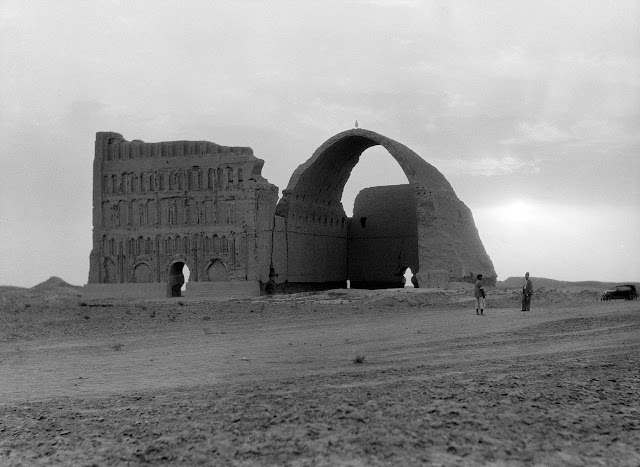The ancient city of Ctesiphon (Also
known Tusbun or Taysafun) on the banks of Tigris, in Baghdad established in the
late 120s BC. The city is located about 35 kilometers southeast of modern
Baghdad actually one of the great cities of late ancient Mesopotamia and the
largest city in the world from 570 AD, until its fall in 637 AD. So during the
Muslim conquest the only surviving structure of Ctesiphon these days is the
majestic vaulted hall of Taq Kasra, which served as the palace of the Sasanian
king Khosrow I, in the late 6th century. The archway is one of the biggest
single-span vaults of unreinforced brickwork in the world. The exact time of
construction is not known with conviction. However, it is believed that construction
possibly started during the reign of Khosrau I after a campaign against the
Byzantines in 540 AD.
Mithradates was founded
Ctesiphon, “the King of Parthian Empire” as a royal residence, after he annexed
Babylonia by defeating the Greeks. Therefore, under the Parthian rule, Ctesiphon
became the political and commercial center of the region, and by the end of 58
BC, it had become the Empire’s capital. Progressively, the city was merged with
the old Hellenistic capital of Seleucia and other adjacent settlements to form
a cosmopolitan metropolis. Moreover, in the 2nd century, the tug-o-war of power
between the Romans and the Parthians affected Ctesiphon to change hands between
the two Empires for a total of six times.
Though the obliteration of the palace
is blamed on different individuals by numerous sources, Abbasid caliph
Al-Mansur (754-775) is most usually mentioned. However, during the last
possession, the Romans kick out and looted the city, demolished palaces and
carried off thousands of its inhabitants as slaves. Consequently, in 226 AD,
the city fell into the hands of the Sasanian Empire, and Ctesiphon prospered
once again. The oldest occupied places of Ctesiphon were on its eastern side,
which in Arabic sources is named "the Old City", where the residence
of the Sasanians, identified as the White Palace, was located. The southern
side of Ctesiphon was recognized as Aspanbar, which was acknowledged by its
protuberant halls, riches, games, stables, and baths.
Thus, after another short-lived
occupation of the city by the Romans, the Sasanian king Khosrau I recuperated
control over Ctesiphon. He then underway building a large palace complex with a
large vaulted arch that is 37 meters tall and 26 meters across. The arch top is
about one meter thick while the walls at the base are up to seven meters thick.
Up to modern times, it was the largest, unverified vault in the world. Besides,
after the Arabs took Ctesiphon in 637 AD, they improvised the palace as a
mosque until the area was slowly abandoned. Hence, by the end of 8th century,
Ctesiphon had been superseded by the lately founded city of Baghdad, and
Ctesiphon’s deserted ruins were used as a quarry for building materials. Consequent
floods demolished all remaining structures, including Taq Kasra, one third of
which was swept away by a flood in 1888.
Henceforth, the striking brick ruin of
Taq Kasra is now all that remains above ground of a city that was, for 7
centuries the main capital of the Iranian successor dynasties of the Parthians
and Sassanids. In the 1980’s the archway rebuilt process was started by Saddam
Hussein's government when the fallen northern wing was moderately rebuilt. Therefore,
all works somehow stopped after the 1991 Gulf War. In 2003, before the US-led
invasion the area boasted gardens and arbores, as well as a popular museum. In
2004, the Global Heritage Fund said that, as a result of disrepair, the arch
was “in danger of collapse”. Taq-e-Kisra was neglected for a long time and decided
to rehabilitate it. However, the current Iraqi government is cooperating with
the University of Chicago's "Diyala Project" to revive its reputation
as a tourism hub has proceeded in fits and starts.




















